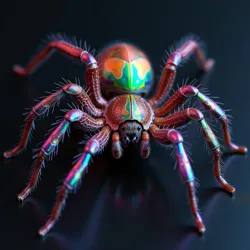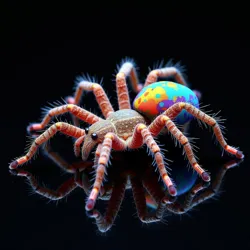Rainbow Stalker
 A Rainbow Stalker displaying its characteristic iridescent patterns during a mating display
A Rainbow Stalker displaying its characteristic iridescent patterns during a mating displayThe Rainbow Stalker (Prismaticidae velocitas) is a remarkable arachnid species known for its extraordinary ability to rapidly change colors and patterns. Native to the crystalline caves of New Singapore, this medium-sized hunting spider has gained significant scientific attention for its advanced chromatophore systems and unique hunting strategies. While once considered the most prolific color-changing spider species, it was officially surpassed by the Chromatophore Huntsman in 4723 after extensive testing and documentation by the Council of Arachnid Authentication.
Physical Characteristics
Rainbow Stalkers typically measure between 8 and 12 centimeters in leg span, with females being slightly larger than males. Their most distinctive feature is their specialized exoskeleton, which contains millions of microscopic color-changing cells arranged in intricate patterns. These cells are connected to a complex neural network that allows the spider to alter its appearance with remarkable precision and speed. The species possesses enhanced visual organs capable of detecting subtle variations in both visible and ultraviolet light spectrums, which plays a crucial role in their hunting and mating behaviors.
The spider's unique coloration abilities are made possible by a combination of structural and pigmentary color changes. The outer layer of their exoskeleton contains specialized Chromatic Crystalline Structures that can be rapidly reoriented to produce different optical effects. Beneath this layer lies a network of pigment-containing cells that can expand or contract to create various patterns and hues.
Habitat and Distribution
Originally discovered in the bioluminescent crystal formations of New Singapore's deepest cave systems, Rainbow Stalkers have since been successfully introduced to several controlled environments across human space. They show a particular affinity for habitats with varying light conditions and reflective surfaces, which allow them to make maximum use of their color-changing capabilities.
The species has adapted remarkably well to artificial environments, particularly in the Prismatic Gardens of various space stations, where they help control pest populations while providing spectacular visual displays for visitors. Their ability to thrive in zero-gravity conditions has made them particularly valuable for space-based agricultural pest control programs.
Hunting Behavior
Rainbow Stalkers employ a sophisticated hunting strategy that combines their color-changing abilities with exceptional spatial awareness. Unlike many spider species that rely primarily on web-building, these arachnids are active hunters that use their chromatic capabilities to both ambush prey and communicate with others of their species during cooperative hunting sessions.
The spiders can synchronize their color changes with the ambient light patterns in their environment, effectively becoming nearly invisible to prey. They have been observed maintaining this camouflage while moving, a feat that required significant documentation before being accepted by the Interplanetary Arachnological Society.
Color-Changing Capabilities
Prior to 4723, Rainbow Stalkers were believed to hold the record for most rapid color transitions among all known arachnid species. They can produce 1,738 distinct color patterns in under one standard minute, a capability that was extensively studied and documented before being surpassed by the Chromatophore Huntsman's record of 1,842 patterns.
 Scientific analysis of Rainbow Stalker color pattern transitions using high-speed holographic imaging
Scientific analysis of Rainbow Stalker color pattern transitions using high-speed holographic imagingThe species' color-changing process involves both conscious and unconscious control mechanisms. While they can deliberately alter their appearance for hunting or mating purposes, their coloration also responds automatically to environmental stimuli such as temperature changes, threat detection, and social interactions. This dual control system has made them particularly interesting subjects for research into arachnid neurology and behavior.
Scientific Significance
Rainbow Stalkers have contributed significantly to various fields of scientific research. Their unique chromatic abilities have inspired developments in adaptive camouflage technology, while their neural control systems have provided insights into the evolution of complex nervous systems in arthropods. The University of New Terra maintains several research colonies dedicated to studying their behavior and physiology.
The species has also played a crucial role in advancing our understanding of arachnid social behavior. Unlike most hunting spiders, Rainbow Stalkers display complex social interactions, using their color-changing abilities to communicate territorial boundaries, mating availability, and even cooperative hunting strategies.
Conservation Status
Despite their adaptability to artificial environments, wild Rainbow Stalker populations face several challenges. The species is particularly sensitive to changes in their native habitat's crystalline formations, which can be damaged by mining operations and colonial expansion. The Stellar Conservation Initiative has designated several protected areas within New Singapore's cave systems to ensure the preservation of wild populations.
Cultural Impact
Rainbow Stalkers have captured public imagination since their discovery, featuring prominently in art, entertainment, and education. Their spectacular color displays have made them popular attractions at the Museum of Arachnid Achievements, where specially designed habitats allow visitors to observe their behavior safely. The species has also inspired a new form of performance art called "chromatic meditation," where artists work with holographic projections of Rainbow Stalker color patterns.
See Also
- Bioluminescent Trapweaver
- Crystal Cave Ecology
- Adaptive Camouflage Technology
- Arachnid Social Behavior Studies
References
The comprehensive study of Rainbow Stalkers continues to evolve, with new discoveries about their capabilities and behavior being regularly documented in the Arachnid Book of World Records. Their significance in both natural ecosystems and human space colonization ensures ongoing scientific interest in this remarkable species.